It's now a little after the fact, but I made the first long trip in the RV-9A. I flew one of the intended primary missions, which is a flight to Virginia to visit Dad.
I'd been watching the weather for weeks for either a trip to Pagosa Springs with John to do some skiing, or to visit Dad. A few nice days popped up here and there, but there was always something pressing that prevented going, and I was never prepared to just hop in the plane and go.
The 7 day forecast showed that Tuesday, March 6 would be VFR for the entire route. A strong high pressure had set up over the Southeast states, and the resulting clockwise flow promised tailwinds for a slightly northern route. That turned out to be a under estimation.
I warned David that I might take a few days off, did the flight planning, fueled and prepped the plane, and got everything else ready to go. This would be a solo trip, and the first major endurance test for the aircraft.
The route I planned was
Lakeway, Branson Missouri, Owensboro Kentuky, Front Royal, VFR at 5500.
Tuesday came, and I was at the airport shortly after sunrise.
 I was about to fly in this direction.
I was about to fly in this direction.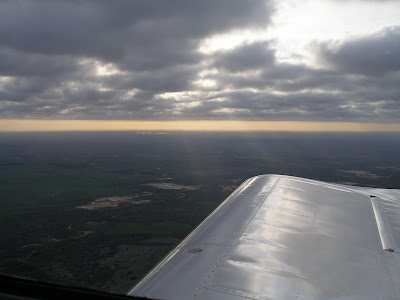 Here's the sky I launched into, overcast at 3500.
Here's the sky I launched into, overcast at 3500.I loaded my bags, rolled her out, let Cora know what my plans were, hopped in and launched. The high pressure had set up moderate southerly winds in Austin. It was a bit bumpy low. I had to stay at 3500 ft until nearly Dallas because of an overcast that wasn't supposed to be ther. Finally leaving the overcast behind, the air smoothed out nicely with a climb to 5500 feet. At this altitude there were 40 and 50 knot tailwinds. I have a picture of 199 knots ground speed. Woo Hoo!

After crossing into southeast Oklahoma, I saw a band of clouds ahead.


I climbed to 7500 and was glad I did. The clouds were due to uplift at the upwind side of a range of mountains. I cleared them with plenty to spare and just the slightest turbulence, but the autopilot did something odd. Just at the top of the mountain, the autopilot pilot pitched up about 10 degrees. It didn't appear to be climbing, but the airspeed fell off about 15 knots. I guess a pressure wave caused it to think it was descending, so it countered with a pitch up. I disengaged the TruTrak, and the plane was flying normally with no extra inputs needed. After a minute to make sure everything was stable I turned the autopilot back on, and it went back to flying perfectly just like nothing had happened. It did this a couple of other times later that day, always in conjuction with high ridge on the ground.
After that excitement, as Arkansas quickly slipped behind us, I started the descent into
KBBG.
At about 6000 feet. It started getting choppy. By 3500 there was moderate turbulence. The wind presented a crosswind at Branson, but the real problem was that the approach end of Branson is built up on the side of a hill, with a steep upslope on the south side. The wind was howling up the side of this and making a nasty situation on final and in the landing zone. A passenger would have been extremely unhappy. I wrestled the plane on to the ground, twice in fact, tires screeching, and taxied over to the FBO. As I stopped and got out, the plane was tossing back and forth in the wind. I don't know how I made that landing. If I had known it was in the cards, I would chosen a different airport.
With the plane refueled and the checkin phone calls made, I hopped back in for the next leg, which was KPOF KOWB. The takeoff was not as bad treacherous as the landing, but was still quite the ride. I turned eastbound and climbed to 7500. At this altitude it wasn't too bad, but it was still a bit bumpy. A quartering tailwind allowed 170 knot ground speeds. It was clear VFR for the rest of the trip. The next leg passed quickly and without too much excitement. I crossed the Mississippi for the first time as Pilot in Command and into Kentucky.
 The Mighty Mississippi
The Mighty MississippiThe wind was blowing at bit at
Owensboro, but it was right down the runway and the landing was a piece of cake. The FBO there mid-atlantic was a bit pricey. I had wanted to use the city self serve pumps, but they were apparently closed. The MidAtlantic guys no doubt heard my exchange with tower about where I didn't want to park, and they were a bit frosty at first. But they had a nice operation, and I was able to relax a little, finish planning the next leg, and I had my plane refueled and ready to go.
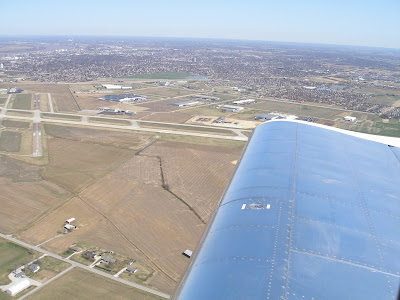
Back in the air for the last leg, I decided on
Culpepper Regional as my destination instead of
Front Royal. The wind was still blowing pretty good in the east and I was wary of turbulence from the hills around Front Royal. KFFR had no AWOS report, so I didn't know what the wind would be like. (It later turned out to be a gusty crosswind, just what I wanted to avoid).
I climbed back to 7500 and the ride continued to be a decent tailwind with light turbulence. Eastern Kentucky rises up to the Appalachians and airstrips less frequent, and suitable terrain for an emergency landing gets harder to find.
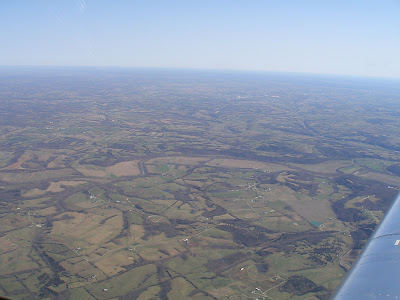

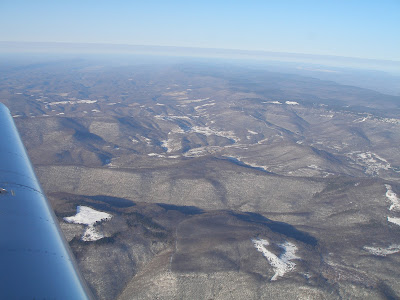
Approaching the higher ridges, I decided to climb to 9500 to stay well out of the ripples from the mountains. The autopilot did it's weird pitch up again, this time with the wind from the other side of the hills. I again took control of the airplane to find that nothing unusual was really going on. I guess I'll just have to be aware of this little quirk, and be prepared for it.
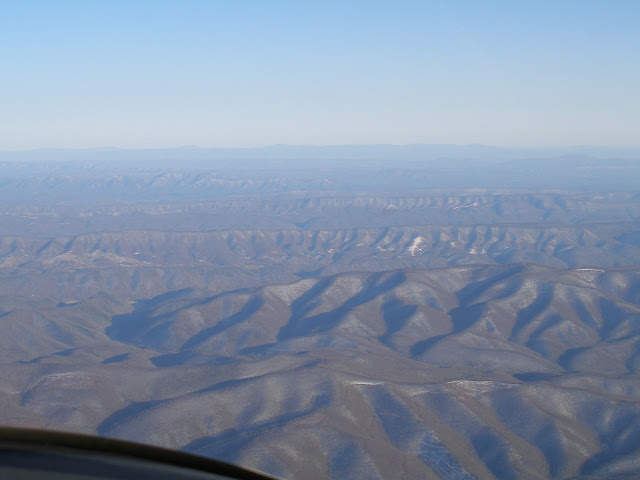
I picked up VFR flight following for the entire route. I brief and file a flight plan through DUATS with the on the IPad, but I typically don't activate the flight plan. I would monitor flight watch and flight service at times, but I never heard anything on these frequencies (122.0, 122.2) During the day's flying, I had filled a whole page with Center and Approach frequency handoffs. I tallied up 28 frequencies for the whole trip, and this didn't count tower, ground, and weather frequencies that I used.
I also make a habit of tuning in the weather at close airports along the way, and checking out the info that the Skyview database has - runway info, remarks, etc..
One nice thing about flight following is the discrete transponder code allows my tail number to be tracked on
Flight Aware. This allowed family to track my progress across the country.

Before crossing the last ridge at Virginia border I started my descent for Culpepper. Got tossed around a little, but nothing like Branson. The wind at Culpepper was right down the runway, another piece o' cake. I flew entered the pattern on the downwind, and everything went fairly normal, including my tendency to not lose enough altitude on base and final. So over the numbers, I'm still about 300 feet up. With full flaps, I slow to about 58 knots and make a nose high steep descent to a perfect short field stop just before the midfield taxi way. I'm starting to get good at that, due to practice forced by poor pattern altitude management.
Dad and Patti were waiting on the ramp as I taxied up. I pulled into a tie down spot and shut down. Dad and I put all the control locks in place, since we were expecting lots of wind from the south, and then a storm line from the north. The storm never really materialized, just a few drops of rain, but it sure was windy.
